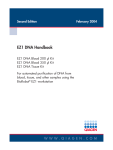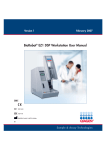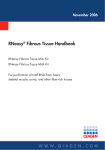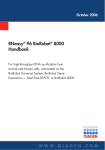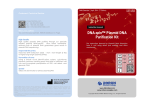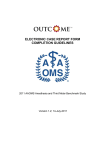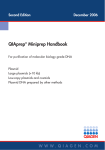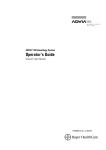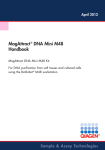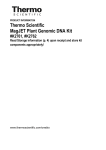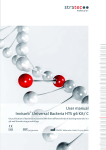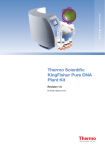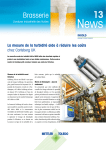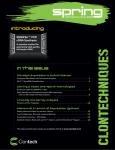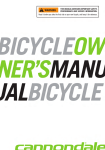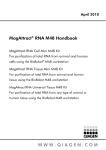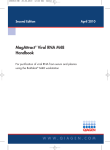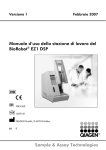Download MagAttract 96 DNA Plant Handbook
Transcript
August 2003 MagAttract® 96 DNA Plant Handbook For efficient high-throughput isolation of DNA from plant tissue W W W. Q I A G E N . C O M Trademarks and disclaimers Patented or patent-pending and/or registered or registration-pending trademarks of the QIAGEN Group: QIAGEN®, QIAsoft™, BioRobot®, MagAttract®. RapidPlate is a registered trademark of Zymark Corporation. Registered names, trademarks, etc. used in this document, even when not specifically marked as such, are not to be considered unprotected by law. The PCR process is covered by U.S. Patents 4,683,195 and 4,683,202 and foreign equivalents owned by Hoffmann-La Roche AG. © 2003 QIAGEN, all rights reserved. 2 MagAttract 96 DNA Plant Handbook 08/2003 Contents Kit Contents 4 Storage Conditions 4 Product Warranty and Satisfaction Guarantee 4 Product Use Limitations 5 Technical Assistance 5 Product Specifications 5 Safety Information 6 Introduction 8 Principle and procedure 9 Disruption of plant tissues 9 Centrifugation 9 Handling guidelines for the Magnet, 96-well, Type B 9 Equipment and Reagents to Be Supplied by the User 10 Protocol: Disruption of Plant Tissue and Preparation of Cleared Lysates 11 Protocol: Manual DNA Purification 13 Protocol: DNA Purification Using the MagAttract 96 DNA Plant Core Kit and BioRobot Plant Science Workstation 15 Recommendations for Using MagAttract Technology with Robotic Systems Protocol: Adaptation of MagAttract Technology to Robotic Systems 19 21 Troubleshooting Guide 23 Appendix A: Protocol Modifications for “Difficult” Plant Material 27 Appendix B: Using 1 ml Round-Well Blocks for the MagAttract 96 DNA Plant Procedure 28 Appendix C: Determination of DNA Concentration and Yield 29 Appendix D: Recovery and Cleaning of Tungsten Carbide Beads 29 Appendix E: Cleaning of S-Blocks 29 Ordering Information 30 MagAttract 96 DNA Plant Handbook 08/2003 3 Kit Contents MagAttract® 96 DNA Plant Core Kit (6) (24) 67161 67163 576 (6 x 96) 2304 (24 x 96) 25 ml 100 ml Buffer RB 200 ml 2 x 200 ml Buffer RLT* 220 ml 4 x 220 ml Buffer RPW* 125 ml 4 x 125 ml RNase A (100 mg/ml) 220 µl 4 x 220 µl Buffer AE 110 ml 3 x 128 ml Catalog no. Number of preps MagAttract Suspension A Storage Conditions All kit components, buffers, and RNase A stock solution can be stored at room temperature (15–25°C). After addition of RNase A and isopropanol, Buffer RPW is stable for 6 months when stored at 2–8°C. Product Warranty and Satisfaction Guarantee QIAGEN guarantees the performance of all products in the manner described in our product literature. The purchaser must determine the suitability of the product for its particular use. Should any product fail to perform satisfactorily due to any reason other than misuse, QIAGEN will replace it free of charge or refund the purchase price. We reserve the right to change, alter, or modify any product to enhance its performance and design. If a QIAGEN® product does not meet your expectations, simply call your local Technical Service Department or distributor. We will credit your account or exchange the product — as you wish. A copy of QIAGEN terms and conditions can be obtained on request, and is also provided on the back of our invoices. If you have questions about product specifications or performance, please call QIAGEN Technical Services or your local distributor (see back cover). * Contains harmful chemicals. Take appropriate laboratory safety measures and wear gloves when handling. Not compatible with bleach. See page 6 for detailed safety information. 4 MagAttract 96 DNA Plant Handbook 08/2003 Product Use Limitations The MagAttract 96 DNA Plant Core Kit is developed, designed, and sold for research purposes only. It is not to be used for human diagnostic or drug purposes or to be administered to humans unless expressly cleared for that purpose by the Food and Drug Administration in the USA or the appropriate regulatory authorities in the country of use. All due care and attention should be exercised in the handling of many of the materials described in this text. Technical Assistance At QIAGEN we pride ourselves on the quality and availability of our technical support. Our Technical Service Departments are staffed by experienced scientists with extensive practical and theoretical expertise in molecular biology and the use of QIAGEN products. If you have any questions or experience any difficulties regarding the MagAttract 96 DNA Plant Core Kit or QIAGEN products in general, please do not hesitate to contact us. QIAGEN customers are a major source of information regarding advanced or specialized uses of our products. This information is helpful to other scientists as well as to the researchers at QIAGEN. We therefore encourage you to contact us if you have any suggestions about product performance or new applications and techniques. For technical assistance and more information please call one of the QIAGEN Technical Service Departments or local distributors (see back cover). Product Specifications MagAttract 96 DNA Plant Core Kit Plant starting material: fresh/frozen Plant starting material: dried/lyophilized DNA yield* Final volume of eluate* 10–100 mg 10–30 mg 1–15 µg 100 µl * Depends on type of plant and preparation protocol used MagAttract 96 DNA Plant Handbook 08/2003 5 Recommended starting amounts and expected yields from different plants Sample Amount Yield (µg DNA/ mg tissue) Total yield (µg) Concentration (ng/µl) Arabidopsis blossom and hull 3 pieces 0.46 4.6 57 Arabidopsis leaf 100 mg 0.05 5.0 62 Barley leaf 30 mg 0.15 4.5 56 Corn leaf 60 mg 0.20 12.0 150 Flax 40 mg 0.14 5.5 64 Rape (Canola) 40 mg 0.14 5.7 67 Rye leaf 30 mg 0.17 5.1 63 Ryegrass (Lolium spp.) 30 mg 0.13 4.0 47 Sunflower leaf 30 mg 0.16 4.8 60 Tobaco leaf 40 mg 1.3 Tomato leaf 50 mg 0.15 7.5 93 Wheat leaf 30 mg 0.16 4.8 60 DNA has also been successfully purified from many other plants, including sugar beet (leaves and seeds), rose, Lactuca serriola, Amaranthus, maple, soy, cotton, rice, peanut, castor, gherkin, red gherkin, spinach, cauliflower, onion, white cabbage, carrot, red beet, bleach celery, and oat. Safety Information When working with chemicals, always wear a suitable lab coat, disposable gloves, and protective goggles. For more information, please consult the appropriate material safety data sheets (MSDSs). These are available online in convenient and compact PDF format at www.qiagen.com/ts/msds.asp where you can find, view, and print the MSDS for each QIAGEN kit and kit component. CAUTION: DO NOT add bleach or acidic solutions directly to the sample-preparation waste. Buffers RPW and RLT contain guanidine hydrochloride/guanidine thiocyanate, which can form highly reactive compounds when combined with bleach. If liquid containing these buffers is spilt, clean with suitable laboratory detergent and water. If the spilt liquid contains potentially infectious agents, clean the affected area first with laboratory detergent and water, and then with 1% (v/v) sodium hypochlorite. The following risk and safety phrases apply to components of the MagAttract 96 DNA 6 MagAttract 96 DNA Plant Handbook 08/2003 Plant Core Kit: Buffer RLT Contains guanidine thiocyanate: harmful. Risk and safety phrases:* R20/21/22-32 S13-26-36-46 Buffer RPW Contains guanidine hydrochloride: harmful, irritant. Risk and safety phrases:* R36/38 S13-26-36-46 RNase A Contains ribonuclease: sensitizer. Risk and safety phrases:* R42/43 S23-24-2636/37 24-hour emergency information Emergency medical information in English, French, and German can be obtained 24 hours a day from: Poison Information Center Mainz, Germany Tel: +49-6131-19240 * R20/21/22: Harmful by inhalation, in contact with skin, and if swallowed; R32: Contact with acids liberates very toxic gas; R36/38: Irritating to eyes and skin; R42/43: May cause sensitization by inhalation and skin contact; S13: Keep away from food, drink, and animal feed; S23: Do not breathe gas, fumes, vapor, or spray; S24: Avoid contact with skin; S26: In case of contact with eyes, rinse immediately with plenty of water and seek medical advice; S36: Wear suitable protective clothing; S36/37: Wear suitable protective clothing and gloves; S46: If swallowed, seek medical advice immediately and show this container or label. MagAttract 96 DNA Plant Handbook 08/2003 7 Introduction The MagAttract 96 DNA Plant Core Kit combines the speed and efficiency of silicabased DNA purification with the convenience of magnetic particles, and is designed for fully automated high-throughput minipreparation of genomic, chloroplast, and mitochondrial DNA from plant tissue. MagAttract technology provides high-purity DNA, which is ready for use in downstream applications, such as PCR. This handbook contains a manual protocol, a general protocol for use of the MagAttract 96 DNA Plant procedure with robotic workstations/magnetic separation devices, and a specific protocol for use with the BioRobot Plant Science Workstation.† † QIAGEN robotic systems are not available in all countries; please inquire. MagAttract Procedure Plant leaf tissue Grind, lyse, and precipitate Microplate FB Add cleared lysate to binding buffer and magnetic particles, mix, and incubate 96-Well Magnet Type B Remove supernatant using the magnet and perform 4 wash cycles Elution Microplate RB Ready-to-use DNA 8 MagAttract 96 DNA Plant Handbook 08/2003 Principle and procedure Fresh, frozen, or lyophilized starting material (10–100 mg) is mechanically disrupted to give a fine powder. The powder is resuspended in lysis buffer, carefully mixed, and then sedimented by a short centrifugation step. The lysates are transferred to 96-well flat-bottom microplates before starting the MagAttract purification procedure. Genomic DNA selectively binds to the surface of MagAttract particles and is further purified by washing the magnetic particles with alcoholcontaining buffers and ethanol. Pure genomic DNA is eluted from the particles with low-salt Buffer AE into a 96-Well Microplate and is ready for use in downstream applications. Disruption of plant tissue For disruption of plant tissue, optimal results are obtained using the TissueLyser together with the TissueLyser Adapter Set 2 x 96 and Tungsten Carbide Beads (stainless steel beads can also be used). The TissueLyser provides rapid and efficient disruption of 2 x 96 samples in 2–4 minutes. Plant material and a 3 mm bead are added to each of 192 collection microtubes in two racks. The racks are fixed into the clamps on the TissueLyser using adapter plates and disrupted by two 1-minute high-speed (30 Hz) shaking steps. We recommend the use of tungsten carbide beads as these provide better and more reproducible results than chrome steel beads. For some samples, such as small seeds, 5 mm beads should be used for grinding to ensure production of a homogenous plant powder. Either fresh or lyophilized plant tissue samples can be processed using the TissueLyser. Frozen material should be disrupted under freezing conditions using liquid nitrogen. Fresh material can also be disrupted in lysis buffer, but this may cause shearing of highmolecular-weight DNA. Lyophilized material should be disrupted without lysis buffer. Centrifugation The recommended speed for the centrifugation step in the protocol is 6000 x g, using the Centrifuge 4-15C or the Centrifuge 4K15C equipped with the QIAGEN Plate Rotor 2 x 96. If these centrifuges are not available, or the recommended speed cannot be applied on the given centrifuge, centrifuge the plates at maximum speed. Increase the time of centrifugation if necessary. Handling guidelines for the Magnet, 96-well, Type B The QIAGEN Magnet, 96-well, Type B is designed for rapid, efficient, and convenient separation of MagAttract particles from solutions in 96-well microplates and round-well blocks. The magnet consists of an array of 24 magnetic NdFeB rods that fit between the wells of a microplate or round-well block. Each magnetic rod quickly attracts the particles in four adjacent wells to one side of each well, and holds the particles in place while the buffer is removed. When the microplate or round-well block is removed from the magnet, the MagAttract particles are easily resuspended in buffer, allowing thorough washing and elution. MagAttract 96 DNA Plant Handbook 08/2003 9 Equipment and Reagents to Be Supplied by the User When working with chemicals, always wear a suitable lab coat, disposable gloves, and protective goggles. For more information, please consult the appropriate material safety data sheets (MSDSs) available from the supplier. Equipment ■ Equipment for disrupting plant tissue. We recommend the TissueLyser with the TissueLyser Adapter Set 2 x 96 and reusable 3 mm tungsten carbide or stainless steel beads for optimal disruption. ■ Centrifuge 4-15C or 4K15C with Plate Rotor 2 x 96 ■ Magnet for separation compatible with 96-well flat-bottom and round-bottom microplates (e.g., QIAGEN Magnet, 96-well, Type B, cat. no. 9012916) ■ Multichannel pipet with 300 µl maximum capacity (for manual preparation) ■ BioRobot Plant Science Workstation, or other robotic workstation for automated processing Consumables ■ Reagent reservoirs for the multichannel pipet (for manual preparation) ■ Collection Microtubes with Collection Microtube Caps (for disruption; cat. nos. 19560 and 19566 or 120008) ■ Flat-bottom 96-well microplates (e.g., 96-Well Microplates FB, cat. no. 36985) ■ Round-bottom 96-well microplates (e.g., 96-Well Microplates RB, cat. no. 19581) Reagents ■ Isopropanol (99–100%) ■ Ethanol (96–100%) ■ Liquid nitrogen 10 MagAttract 96 DNA Plant Handbook 08/2003 This protocol can be used for disruption of 192 (2 x 96) plant tissue samples using the TissueLyser (see “Disruption of plant tissue”, page 9). After addition of lysis buffer, cleared lysates are prepared by centrifugation. IMPORTANT: The optimal amount of starting material depends on the plant type and its state (fresh or lyophilized). We recommend using up to 100 mg fresh plant material, or up to 30 mg lyophilized material, and performing a preliminary experiment with different amounts of starting material. Procedure 1. Place a plant tissue sample into each tube of two collection microtube racks. Keep the clear covers from the collection microtube racks for use in step 4. Normally 30 mg of starting material is sufficient. Do not use more than 50 mg (wet weight) unless preliminary experiments suggest that the optimal amount is higher. 2. Add one tungsten carbide or stainless steel bead to each collection microtube and seal the tubes with the caps supplied. Note that Buffer RLT may corrode tungsten carbide beads if samples are stored for more than 6 hours. 3. Cool the collection microtubes in liquid nitrogen. Ensure that the microtubes remain tightly closed. 4. Place a clear cover (saved from step 1) over each rack of collection microtubes and knock the racks upside down against the bench 5 times to ensure that all tungsten carbide beads can move freely within the collection microtubes. Ensure that no liquid nitrogen remains, but do not allow the leaf material to thaw. Remove the clear cover. 5. Sandwich each rack of collection microtubes between adapter plates and fix into the TissueLyser clamps as described in the TissueLyser instruction manual. Ensure that the microtubes are properly sealed with caps. IMPORTANT: Two plate sandwiches must be clamped to the TissueLyser to provide balance. To process 96 or fewer samples, assemble a second plate sandwich using a rack of collection microtubes containing tungsten carbide beads but no samples or buffers, and fix it into the empty clamp. 6. Shake the samples for 1 min at 30 Hz. 7. Remove and dismantle the plate sandwiches. Ensure that the collection microtubes are tightly closed. Cool the collection microtube racks again in liquid nitrogen and then knock the racks against the bench 5 times to ensure that no tissue powder remains in the caps. MagAttract 96 DNA Plant Handbook 08/2003 11 Protocol Tissue Disruption Protocol: Disruption of Plant Tissue and Preparation of Cleared Lysates Protocol Tissue Disruption 8. Reassemble the plate sandwiches so that the collection microtubes nearest the TissueLyser in steps 5 and 6 are now outermost. Reinsert the plate sandwiches into the TissueLyser. Rotating the racks of collection microtubes in this way ensures that all samples are thoroughly disrupted. IMPORTANT: Merely rotating the entire plate sandwich so that the QIAGEN logos are upside down when reinserted into the TissueLyser is not sufficient, since the samples that were outermost during the initial disruption will remain outermost in the second disruption step. 9. Shake the samples for 1 min at 30 Hz. 10. Carefully remove the caps from the collection microtubes and immediately pipet 300 µl Buffer RLT into each collection microtube. 11. Reseal the tubes with the caps and shake the entire rack in an upright position 20 times back and forth. Vortex the rack of collection microtubes upside down at full speed for 20 s. 12. Centrifuge the rack of collection microtubes for 5 min at 6000 x g. 13. Proceed with the relevant purification protocol. 12 MagAttract 96 DNA Plant Handbook 08/2003 Protocol: Manual DNA Purification Things to do before starting Add 125 ml isopropanol and 1 vial RNase A (1 x 220 µl) to each bottle of Buffer RPW (125 ml) before use. ■ Shake the bottle containing MagAttract Suspension A and vortex for 5 minutes (before first use) or 1 minute (before subsequent uses) to ensure that the magnetic particles are fully resuspended before use. Procedure 1. Add 65 µl of Buffer RB to each well of a flat-bottom microplate or 1.5 ml microcentrifuge tube. 2. Add 20 µl of resuspended MagAttract Suspension A to each well of the 96-well flat-bottom microplate or into the 1.5 ml microcentrifuge tube. Note: Buffer RB and MagAttract Suspension A can be combined in appropriate proportions to make a master mix before starting the procedure. Add 85 µl of the master mix to each well of the 96-well flat-bottom microplate. Ensure that the MagAttract particles are fully resuspended. 3. Transfer 200 µl plant lysate supernatant into each well of the microplate or into the microcentrifuge tube, and mix by pipetting up and down several times. 4. Incubate at room temperature (15–25°C) for 5 min. Mix once during incubation. Note: Mixing can be done by pipetting using an 8-channel pipet. The pipet tips needed for this step can be reused if they are returned to the tip rack after use. To avoid cross-contamination, ensure that the same tip is always used for the same well. When using microcentrifuge tubes, samples can be mixed by vortexing. 5. Place the plate or microcentrifuge tube on the magnet and remove the supernatant after magnetic separation 6. Wash the pelleted MagAttract particles by adding 200 µl Buffer RPW, resuspending the particles, placing the plate or tube on the magnet, and removing the supernatant. Note: Resuspension of the magnetic particles should be done very carefully since the efficiency of washing is directly related to how well the particles are resuspended. Resuspension can be performed by pipetting (see previous note) or by vortexing. If 96-well plates are vortexed, the initial mixing should be done very carefully to avoid spilling the magnetic particle suspension out of the wells and contaminating others. If this is too difficult with an initial volume of 200 µl, add 100 µl of Buffer RPW, vortex, and then add an additional 100 µl. 7. Wash the pelleted MagAttract particles by adding 200 µl ethanol (96–100%), resuspending the particles, placing the plate or tube on the magnet, and removing the supernatant. MagAttract 96 DNA Plant Handbook 08/2003 13 Protocol Manual Procedure ■ 8. Repeat step 7, aspirating as much ethanol as possible. 9. Dry the MagAttract particles for 5–10 min at room temperature (15–25°C). 10. Resuspend the MagAttract particles in 100 µl Buffer AE. 11. Incubate at room temperature for 5 min. Protocol Manual Procedure 12. Place the plate or microcentrifuge tube on a magnet and transfer the DNA eluates to a clean 96-well round-bottom microplate or microcentrifuge tube. 14 MagAttract 96 DNA Plant Handbook 08/2003 Protocol: DNA Purification Using the MagAttract 96 DNA Plant Core Kit and the BioRobot Plant Science Workstation Plant genomic DNA minipreps can be prepared using the MagAttract 96 DNA Plant Core Kit on the BioRobot Plant Science Workstation. The following information provides details of the preparation required for this procedure. Full descriptions of the preparation procedure and protocol are provided with the BioRobot Plant Science System. A MagAttract protocol using the BioRobot RapidPlate for automation of some steps is also available upon request from QIAGEN Technical Services. Equipment In addition to the BioRobot RapidPlate Workstation, this protocol requires a BioRobot 3000 Workstation with the following configuration: ■ 0.9 mm steel probes ■ Optional: Tip change system ■ High-Speed Pipetting System, external ■ Shaker System, 4-plate ■ 2500 µl Dilutor Units MagAttract 96 DNA Plant Handbook 08/2003 15 Protocol BioRobot Workstation The BioRobot Plant Science Workstation consists of a BioRobot 3000 Workstation and a RapidPlate 96-well pipetting device. In the MagAttract Plant procedure, the BioRobot 3000 Workstation distributes the MagAttract Plant suspension for binding and the buffers for washing and elution steps. It also resuspends the beads by shaking, and efficiently removes ethanol from the beads by drying on the integrated cooling and heating device. Magnetic separation is performed on the RapidPlate 96-well pipetting device, which also enables rapid removal of supernatants and wash buffers, and transfers eluates into a microplate, without cross contamination. For further information, refer to the BioRobot 3000 and BioRobot RapidPlate User Manual. ■ Cooling and Heating System (with heat-transfer adapter, flat bottom) ■ Robotic Handling System, T-grip ■ Two Reagent Holders, 3-trough, 20 ml ■ Magnet, 96-well, Type B (cat. no. 9012916) Protocol BioRobot Workstation Consumables ■ Non-porous tape sheets for sealing 96-well microplates (e.g., Tape Pads, cat. no. 19570) ■ Flat-bottom 96-well microplates (e.g., 96-Well Microplates FB, cat. no. 36985) ■ Round-bottom 96-well microplates (e.g., 96-Well Microplates RB, cat. no. 19581) ■ Disposable Troughs, 20 ml (cat. no. 9232764) ■ Two 96-well blocks with 2.2 ml wells (e.g., S-Blocks, cat. no. 19585) ■ Optional: One rack of Disposable Tips (300 µl) for the BioRobot 3000 ■ One rack of Disposable Tips (200 µl) for the BioRobot RapidPlate Workstation Things to do before starting ■ Add 125 ml isopropanol and 1 vial RNase A (1 x 220 µl) to each bottle of Buffer RPW (125 ml) before use. Transfer the solution into a 500 ml bottle with a luer adapter (provided with the BioRobot Workstation). ■ Shake the bottle containing MagAttract Suspension A and vortex for 5 minutes (before first use) or 1 minute (before subsequent uses) to ensure that the MagAttract particles are fully resuspended before filling the disposable trough. ■ Fill each well of a 96-well block (2.2 ml wells) with 1 ml distilled water. 16 MagAttract 96 DNA Plant Handbook 08/2003 Recommendations for Using MagAttract Technology with Robotic Systems The following guidelines should be followed when using robotic liquid handling and processing platforms for the MagAttract 96 DNA Plant procedure, and as a starting point for optimization. All automated protocols for the MagAttract 96 DNA Plant Core Kit start with cleared plant lysates (step 13 on page 12). Robotic platforms should be equipped with the following features: ■ At least an 8-channel pipetting system; ideally a 96-channel system in addition to a 4- or 8-channel system ■ Plate handling device (“robotic hand”) to move plates ■ Plate shaker with a shaking speed higher than 500 rpm for resuspension of magnetic particles ■ Magnet for separation (e.g., QIAGEN Magnet, 96-well, Type B) ■ Plate heating device to dry MagAttract particles (optional) Since different robotic platform have different features and programming options, we can provide only general recommendations for the MagAttract 96 DNA Plant procedure. The main steps of the protocol are summarized below. A fully automated protocol on the QIAGEN BioRobot Plant Science Workstation is also available (page 15). Dispensing MagAttract Suspension A MagAttract particles sediment if stored without agitation. To ensure a uniform distribution of particles, shake the magnetic particle suspension before dispensing. To resuspend the MagAttract particles, we recommend pipetting 4 ml of MagAttract Suspension A into a 20 ml trough and shaking the trough for 90 seconds at 600 rpm on a plate shaker that is integrated in the worktable. The trough holder should have an “SBS-Standard” footprint for fitting into the plate shaker. Resuspension of the pelleted MagAttract particles after magnetic separation Some robotic devices are not capable of resuspending MagAttract particles by pipetting repeatedly after magnetic separation. If this is the case, we recommend: 1. Addition of 100 µl Buffer RPW (wash buffer) 2. Resuspension of magnetic particles on a plate shaker (2 minutes at 800 rpm) 3. Adding an additional 100 µl buffer in each of the three wash steps to increase the wash efficiency MagAttract 96 DNA Plant Handbook 08/2003 17 When using repeated pipetting to resuspend magnetic particles, the following guidelines may help: 1. Apply low-speed pipetting to loosen the pellet 2. Apply high-speed pipetting for efficient homogenization of the particles once the pellet is loosened Removal of the supernatant after magnetic separation Before elution, the MagAttract particles should be dried to remove the remaining ethanol. This step can be done at room temperature (15–25°C), but the time for drying can be reduced and the reproducibility improved if the robotic workstation has an integrated heating device for microplates. We recommend drying the particles for 7 minutes at 50°C, although the drying time is dependent on the efficiency of the removal of the supernatant after the last wash cycle. Note: The particles should not be overdried, since this makes resuspension of the particles in elution buffer on an automated workstation very difficult. An alternative to the drying step The particles can be rinsed with distilled water while the microplate is on the magnet. The plate is kept on the magnet after removal of the supernatant from the last wash cycle, to keep the particles fixed to the wall of the wells. Distilled water is then dispensed into the wells and is immediately aspirated. All pipetting is carried out at low speed. Note: Rinsing the MagAttract particles with water while they are attracted to the magnet may slightly decrease the yield of DNA. 18 MagAttract 96 DNA Plant Handbook 08/2003 Protocol: Adaptation of MagAttract Technology to Robotic Systems Some steps of the MagAttract 96 DNA Plant procedure can be automated using a standalone 96-channel pipetting device such as the BioRobot RapidPlate (protocol available upon request from QIAGEN Technical Services). Walkaway automation can be established on some workstations. This section provides general guidelines for establishing the MagAttract procedure on robotic systems. Things to do before starting ■ Add 125 ml isopropanol and 1 vial RNase A (1 x 220 µl) to each bottle of Buffer RPW (125 ml) before use. ■ Shake the bottle containing MagAttract Suspension A and vortex for 5 minutes (before first use) or 1 minute (before subsequent uses) to ensure that the magnetic particles are fully resuspended before filling the reagent reservoir. 1. Add 65 µl of Buffer RB to each well of a 96-well flat-bottom microplate. 2. Add 20 µl of resuspended MagAttract Suspension A to each well of the 96-well flat-bottom microplate containing Buffer RB. Note: Buffer RB and MagAttract Suspension A can be combined in appropriate proportions to make a master mix before starting the procedure. Add 85 µl master mix to each well of the 96-well flat-bottom microplate. Ensure that the MagAttract particles are fully resuspended. 3. Carefully transfer 200 µl of each supernatant from the plant lysates to the 96-well flat-bottom microplate containing MagAttract Suspension A and Buffer RB. Mix the samples thoroughly by pipetting up and down several times. 4. Incubate the samples for 2 min at room temperature (15–25°C). Mix thoroughly by pipetting up and down and incubate for an additional 2 min at room temperature. 5. Place the flat-bottom microplate onto a suitable magnet, allow the MagAttract particles to separate for 20 s, and then remove the supernatant. Some robotic systems are capable of removing the supernatant slightly off-center of each well. This minimizes the danger of particle carryover. 6. Add 200 µl of Buffer RPW and resuspend the pelleted MagAttract particles thoroughly by pipetting up and down or by shaking. 7. Place the flat-bottom microplate onto the magnet, allow the MagAttract particles to separate for 20 s, and remove the supernatant. 8. Add 200 µl of ethanol (96–100%) and resuspend the MagAttract particles thoroughly by pipetting up and down or by shaking. MagAttract 96 DNA Plant Handbook 08/2003 19 Protocol Other Robotic Systems Procedure 9. Place the flat-bottom microplate onto the magnet, allow the MagAttract particles to separate for 20 s, and remove the supernatant. 10. Repeat steps 8 and 9. During the final removal of the supernatant, try to aspirate as much of the ethanol as possible. 11. Dry the MagAttract particles for 5–10 min at room temperature. 12. Add 100 µl of Buffer AE to each well, resuspend the MagAttract particles thoroughly by pipetting up and down and/or vortexing, and incubate for 5 min at room temperature. 13. Place the flat-bottom microplate onto the magnet, allow the MagAttract particles to separate for 1 min, and transfer the supernatant to a clean 96-well round-bottom microplate. The DNA can be quantified directly or used for downstream reactions. Protocol Other Robotic Systems Note: This step can be repeated if particle carryover occurs. We also recommend repeating it if the purified DNA is to be used in highly sensitive downstream applications. 20 MagAttract 96 DNA Plant Handbook 08/2003 Troubleshooting Guide This troubleshooting guide may be helpful in solving any problems that may arise. The scientists in QIAGEN Technical Services are always happy to answer any questions you may have about either the information and protocols in this handbook or molecular biology applications (see back cover for contact information). Comments and suggestions Low or no DNA recovery a) Low DNA content of the Increase the amount of starting material, but do not use plant tissue more than 150 mg. b) Insufficient sample disruption Ensure that the starting material is completely disrupted. See “Disruption of plant tissue”, page 9. c) Insufficient sample lysis Ensure that the starting material is resuspended thoroughly in Buffer RLT. Frozen samples should be resuspended immediately after disruption. Do not allow samples to thaw. If multiple Collection Microtube racks are to be processed, store the disrupted samples at –20°C before resuspending in Buffer RLT. d) Incorrect binding conditions Make sure that the correct amount of Buffer RB was added to the samples. Note: Some plants contain secondary metabolites, which may influence the binding of DNA to the MagAttract particles (see next point). e) Oils or other secondary In future preparations, try the protocol modifications for metabolites may interfere “difficult” plant materials suggested in Appendix A, with the binding process page 27. f) MagAttract particles were not completely resuspended Before starting the procedure, ensure that the MagAttract particles are fully resuspended. Vortex for at least 5 min before first use, and for 1 min before subsequent uses. g) Buffer RPW did not contain isopropanol Isopropanol must be added to Buffer RPW before use. Repeat procedure with correctly prepared Buffer RPW. h) The robotic workstation could not detect the elution buffer The robotic workstation could have problems with liquid detection if distilled water is used for elution. Use Buffer AE for elution to prevent this problem. MagAttract 96 DNA Plant Handbook 08/2003 21 Comments and suggestions Contamination of RNA in the eluate Buffer RPW did not contain RNase A RNase A must be added to Buffer RPW before use. Repeat procedure with correctly prepared Buffer RPW. A low level of RNA contamination may not affect the results of quantitative PCR. Magnetic particles in the eluate Magnetic particle carryover Remove supernatant from MagAttract particles carefully, and from slightly off-center of each well. However, magnetic particles do not interfere with enzymatic reactions, such as PCR. Overestimation of DNA yield upon spectrophotometric analysis a) RNA contamination in the eluate Check that RNase A was added to Buffer RPW. Overestimation of yield can lead to failure of downstream applications. b) Insufficient washing of Change the pipetting speeds and their duration, or the MagAttract particles increase the number of wash steps to improve the wash efficiency. “Salt-peaks” at 200–240 nm in spectrophotometric scans Insufficient washing of the MagAttract particles Change the pipetting speeds and their duration or the number of wash steps to improve the wash efficiency. However, salt carryover does not necessarily interfere with downstream applications. Green-, red-, or yellow-colored eluates Insufficient washing of the MagAttract particles Chlorophyll or carotenoids can be efficiently removed by adding one additional wash step using ethanol or by reducing the amount of starting material in future preparations. Slight color in the eluate does not necessarily interfere with downstream applications. Pipetting problems a) Lysate too viscous 22 In future preparations, reduce the amount of starting material and/or increase the volume of Buffer RLT to 400–600 µl. Use 200 µl of supernatant in the MagAttract 96 DNA Plant procedure. MagAttract 96 DNA Plant Handbook 08/2003 Comments and suggestions b) Viscous and turbid lysates If seeds are used as starting material, the crude lysate may be very viscous and turbid. This may result in low yields of DNA, problems with sample processing, and carryover of inhibitors. Generally, a turbid lysate indicates that too much plant material was used. For optimal results, reduce the amount of starting material. If it is not possible to use less material, we recommend increasing the volume of Buffer RLT to 400–600 µl. If the ground material is highly absorbent, larger buffer volumes may be used. Use 200 µl of supernatant in the MagAttract 96 DNA Plant procedure. c) After binding of the DNA to the particles, the particles clump and form large complexes, making liquid handling difficult In future preparations, reduce the amount of starting material and/or increase the volume of Buffer RLT to 400–600 µl. Use 200 µl of supernatant in the MagAttract 96 DNA Plant procedure. Variation of yields across the plate a) Varying amount of starting material across the plate Adjust the amounts of starting materials accordingly. b) Racks of collection microtubes not turned during disruption (when using TissueLyser) It is essential to turn the racks of collection microtubes during disruption in the TissueLyser to ensure that all samples are evenly disrupted (see page 12, step 8). c) Non-uniform sample disruption when using alternative disruption methods Ensure that all samples are uniformly disrupted. MagAttract 96 DNA Plant Handbook 08/2003 23 Comments and suggestions DNA does not perform well in downstream experiments a) Ethanol carryover b) Insufficient/excess DNA Optimize the amount of DNA used in the downstream used in downstream application, if necessary. Downstream applications can application be adversely affected by insufficient or excess DNA. c) Salt carryover Change the pipetting speeds and their duration, or increase the number of wash steps to improve the wash efficiency. d) Eluate is slightly green or yellow See “Green-, red-, or yellow-colored eluates”. 24 Aspirate as much of the ethanol in the final wash step as possible. Dry the particles before elution to remove residual ethanol. MagAttract 96 DNA Plant Handbook 08/2003 Appendix A: Protocol Modifications for “Difficult” Plant Materials Some plant material used for DNA purification may yield low amounts of DNA and/or potential inhibitors of PCR may be co-purified. Carefully following the protocols in this handbook is important to optimize yields. If low yields or co-purification of inhibitors still occur, we recommend the following strategy. Note: The automation protocols must be adapted to include the appropriate volume settings and worktable accessories. Problem Suggestion Low yield of DNA Replace Buffer RB (65 µl) with ethanol (225 µl). For some plant material, yields are higher if the binding conditions are modified by the addition of ethanol. Check whether your magnetic separation principle/device is suited for this option, because addition of alcohol affects the physical behavior of the magnetic particles. Note that the ethanol substitution for Buffer RB is not suitable for the automated BioRobot Plant Science protocol. Inhibition of PCR Replace Buffer RLT by Buffer AP1 (not included in the kit: contact QIAGEN Technical Services for details). Note that in many cases, the yield will be lower (depending on the sample source), but the performance in PCR may be better. Increase the volume of Buffer RLT used for lysis to up to 400–600 µl, but process only the recommended 200 µl of lysate for DNA purification. These recommendations can also be followed when using Buffer AP1. Polyphenolic compounds may be copurified with some plant materials and these can inhibit downstream reactions. Polyphenols can be removed by adding 33 mg/ml insoluble polyvinyl polypyrrolidone (PVPP) to Buffer RLT before use. PVPP forms complex hydrogen bonds with polyphenolic compounds, which are then separated from the DNA during the lysate centrifugation step. Prepare a small aliquot of Buffer RLT containing 33 mg/ml PVPP and thoroughly vortex the modified lysis buffer before use. MagAttract 96 DNA Plant Handbook 08/2003 25 Problem Suggestion Low yields and inhibition of PCR Replace Buffer RLT with Buffer AP1. Replace Buffer RB (65 µl) with ethanol (225 µl). Check whether your magnetic separation principle/ device is suited for this option, because addition of alcohol affects the physical behavior of the magnetic particles. Note that the ethanol substitution for Buffer RB is not suitable for the automated BioRobot Plant Science protocol. Appendix B: Using 1 ml Round-Well Blocks for the MagAttract 96 DNA Plant Procedure Round-well blocks with 1 ml wells can be used on some robotic workstations, allowing larger volumes of plant lysate to be processed. The protocol can be adapted to these plates, but note that standard 96-well microplates may provide better results on some workstations. The use of 1 ml round-well blocks may result in insufficient resuspension of the magnetic particles after magnetic separation. The following recommendations for adaptation of the MagAttract 96 DNA Plant procedure to 1 ml round-well blocks are provided as a guide: ■ Resuspend the disrupted plant material in 500 µl Buffer RLT ■ Add 400 µl cleared plant lysate to 130 µl Buffer RB and 20 µl MagAttract Suspension A ■ Use 200–400 µl of Buffer RPW for the first washing step, followed by 200–400 µl ethanol for the second and third washing steps The volume of wash buffer required is dependent on the speed of the shaking platform used to resuspend the MagAttract particles. 26 MagAttract 96 DNA Plant Handbook 08/2003 Appendix C: Determination of DNA Concentration and Yield DNA concentration can be determined by measuring the absorbance at 260 nm (A260) in a spectrophotometer. For greatest accuracy, absorbance readings at 260 nm should be between 0.1 and 1.0. Sample dilution should be adjusted accordingly: for example, an eluate with an expected DNA concentration of 25–50 ng/µl (A260 = 0.5–1) should not be diluted more than fourfold for spectrophotometry. An absorbance of 1 at 260 nm corresponds to 50 µg DNA per ml. This relationship is only valid for measurements made in water, therefore samples should be diluted in water. Use water to zero the spectrophotometer. We recommend measuring the absorbance at 260 nm of the purified MagAttract 96 DNA Plant samples using a fourfold dilution. DNA yields from different plant species depend greatly on genome size and ploidy and also on the age and growth state of the plant. Appendix D: Recovery and Cleaning of Tungsten Carbide Beads or Stainless Steel Beads Tungsten carbide beads are designed for repeated use. Used tungsten carbide beads can be recovered from cell-debris pellets and cleaned using the procedure below. 1. Seal the collection microtubes with caps. Place a clear cover (saved from step 1 of the MagAttract 96 DNA Plant procedure, page 11) over each rack of collection microtubes and knock the racks upside down against the bench 5 times to free the tungsten carbide beads from the surrounding material. 2. Empty the contents of the microtubes into a fine sieve and rinse the beads thoroughly with water. 3. Incubate beads in 0.4 M HCl for 1 min at room temperature (15–25°C) to degrade any DNA and avoid cross-contamination in future preparations. 4. Rinse beads thoroughly with distilled water to remove the HCl. Appendix E: Cleaning of S-Blocks To avoid cross contamination, after each use rinse the S-Blocks thoroughly in tap water, incubate for 1 min at room temperature in 0.4 M HCl, empty, and wash thoroughly with distilled water. Used S-Blocks can also be autoclaved after washing. Additional S-Blocks can be ordered separately (see Ordering Information, page 30). MagAttract 96 DNA Plant Handbook 08/2003 27 Ordering Information Product Contents Cat. No. MagAttract 96 DNA Plant Core Kit (6) MagAttract Suspension A and buffers for 6 x 96 minipreps 67161 MagAttract 96 DNA Plant Core Kit (24) MagAttract Suspension A and buffers for 24 x 96 minipreps 67163 MagAttract 96 DNA Plant Core Kit (10 x 24) MagAttract Suspension A and buffers for 10 x 24 x 96 minipreps 67165 Collection Microtubes (racked) Nonsterile polypropylene tubes (1.2 ml), 960 in racks of 96 19560 Collection Microtube Caps Nonsterile polypropylene caps for collection microtubes (1.2 ml), 960 in strips of 8 19566 Collection Microtubes (24) Nonsterile polypropylene tubes (1.2 ml) and caps, 24 racks with 96 tubes 96-Well Microplates FB (24) 96-well microplates with flat-bottom wells, 24 per case, for use with the 96-Well Magnet 36985 96-Well Microplates RB (24) 96-well microplates with round-bottom wells plus lids, 24 per case 19581 Tape Pads (5) Adhesive tape sheets for sealing multiwell plates and blocks: 25 sheets per pad, 5 pads per pack 19570 S-Blocks 96-well blocks with 2.2 ml wells, 24 per case 19585 Accessories Magnet, 96-Well, Type B 120008 9012916 TissueLyser 24 Universal laboratory mixer mill, for 24 samples Inquire TissueLyser 96 Universal laboratory mixer mill, for 96 samples Inquire 28 MagAttract 96 DNA Plant Handbook 08/2003 Notes MagAttract 96 DNA Plant Handbook 08/2003 29 Notes 30 MagAttract 96 DNA Plant Handbook 08/2003 QIAGEN Companies Please see the back cover for contact information for your local QIAGEN office. QIAGEN Distributors Argentina Tecnolab S.A. Tel: (011) 4555 0010 Fax: (011) 4553 3331 E-mail: [email protected] Web site: www.tecnolab.com.ar Austria VWR International GmbH Tel: (01) 576 00 0 Fax: (01) 576 00 600 E-mail: [email protected] Web site: www.vwr.com Belgium/Luxemburg Westburg b.v. Tel: 0800-1-9815 Fax: (31) 33-4951222 E-mail: [email protected] Web site: www.westburg.nl Brazil Uniscience do Brasil Tel: 011 3622 2320 Fax: 011 3622 2323 E-mail: [email protected] Web site: www.uniscience.com China Gene Company Limited Tel: (852)2896-6283 Fax: (852)2515-9371 E-mail: Hong Kong:[email protected] Beijing: [email protected] Shanghai: [email protected] Chengdu: [email protected] Guangzhou: [email protected] Egypt Clinilab Tel: Fax: E-mail: 52 57 212 52 57 210 [email protected] Finland VWR International Oy Tel: (09) 804 551 Fax: (09) 8045 5200 E-mail: [email protected] Web site: www.vwr.com Greece BioAnalytica S.A. Tel: (210)-640 03 18 Fax: (210)-646 27 48 E-mail: [email protected] Hungary Kasztel-Med Co. Ltd. Tel: (01) 385 3887 Fax: (01) 381 0695 E-mail: [email protected] Web site: www.kasztel.hu India Genetix Tel: or Fax: E-mail: (011)-2542 1714 (011)-2515 9346 (011)-2546 7637 [email protected] New Zealand Biolab Ltd Tel: (09) 980 6700 or 0800 933 966 Fax: (09) 980 6788 E-mail: [email protected] Web site: www.biolabgroup.com/nzl Norway VWR International AS Tel: 22 90 00 00 Fax: 22 90 00 40 E-mail: [email protected] Web site: www.vwr.com Poland Syngen Biotech Sp.z.o.o. Tel: (071) 351 41 06 or 0601 70 60 07 Fax: (071) 351 04 88 E-mail: [email protected] Web site: www.syngen.pl Taiwan TAIGEN Bioscience Corporation Tel: (02) 2880 2913 Fax: (02) 2880 2916 E-mail: [email protected] Thailand Theera Trading Co. Ltd. Tel: (02) 412-5672 Fax: (02) 412-3244 E-mail: [email protected] Turkey Medek Medikal Ürünler ve Saglik Hizmetleri A. S. Tel: (216) 302 15 80 Fax: (216) 302 15 88 E-mail: [email protected] All other countries QIAGEN GmbH, Germany Portugal IZASA PORTUGAL, LDA Tel: (21) 424 7312 Fax: (21) 417 2674 Singapore Research Biolabs Pte Ltd Tel: 62731066 Fax: 62734914 E-mail: [email protected] Israel Westburg (Israel) Ltd. Tel: 08-6650813/4 or 1-800 20 22 20 (toll free) Fax: 08-6650934 E-mail: [email protected] Web site: www.westburg.co.il Slovak Republic BIO-CONSULT Slovakia spol. s.r.o. Tel/Fax: (02) 5022 1336 E-mail: [email protected] Web site: www.bio-consult.cz Croatia INEL Medicinska Tehnika d.o.o. Tel: (01) 2984-898 Fax: (01) 6520-966 E-mail: [email protected] Korea LRS Laboratories, Inc. Tel: (02) 924-86 97 Fax: (02) 924-86 96 E-mail: [email protected] Web site: www.lrslab.co.kr Slovenia MEDILINE d.o.o. Tel: (01) 830-80-40 Fax: (01) 830-80-70 or (01) 830-80-63 E-mail: [email protected] Cyprus Scientronics Ltd Tel: 02-357 22 765416 Fax: 02-357 22 764614 E-mail: [email protected] Malaysia RESEARCH BIOLABS SDN. BHD. Tel: (603)-8070 3101 Fax: (603)-8070 5101 E-mail: [email protected] Web site: www.researchbiolabs.com South Africa Southern Cross Biotechnology (Pty) Ltd Tel: (021) 671 5166 Fax: (021) 671 7734 E-mail: [email protected] Czech Republic BIO-CONSULT spol. s.r.o. Tel/Fax: (420) 2 417 29 792 E-mail: [email protected] Web site: www.bio-consult.cz Mexico Quimica Valaner S.A. de C.V. Tel: (55) 55 25 57 25 Fax: (55) 55 25 56 25 E-mail: [email protected] Spain IZASA, S.A. Tel: (93) 902.20.30.90 Fax: (93) 902.22.33.66 E-mail: [email protected] Denmark VWR International A/S Tel: 43 86 87 88 Fax: 43 86 87 90 E-mail: [email protected] Web site: www.vwr.com The Netherlands Westburg b.v. Tel: (033)-4950094 Fax: (033)-4951222 E-mail: [email protected] Web site: www.westburg.nl Sweden VWR International AB Tel: (08) 621 34 00 Fax: (08) 760 45 20 E-mail: [email protected] Web site: www.vwr.com MagAttract 96 DNA Plant Handbook 08/2003 31 Australia ■ QIAGEN Pty Ltd ■ ABN 75 072 382 944 ■ PO Box 25 ■ Clifton Hill ■ Victoria 3068 Orders 03-9489-3666 Fax 03-9489-3888 Technical 1-800-243-066 ■ ■ Canada ■ QIAGEN Inc. ■ 2800 Argentia Road ■ Unit 7 ■ Mississauga ■ Ontario ■ L5N 8L2 Orders 800-572-9613 ■ Fax 800-713-5951 ■ Technical 800-DNA-PREP (800-362-7737) France ■ QIAGEN S.A. ■ 3 avenue du Canada ■ LP 809 ■ 91974 COURTABOEUF CEDEX Orders 01-60-920-920 ■ Fax 01-60-920-925 ■ Technical 01-60-920-930 Germany ■ QIAGEN GmbH ■ QIAGEN Strasse 1 ■ 40724 Hilden Orders 02103-29-12000 ■ Fax 02103-29-22000 ■ Technical 02103-29-12400 Italy ■ QIAGEN S.p.A. ■ Via Grosio, 10/10 ■ 20151 Milano Orders 02-33430411 ■ Fax 02-33430426 ■ Technical 02-33430414 Japan ■ QIAGEN K.K. ■ Forefront Tower II ■ 13-1, Kachidoki 3 Chome ■ Chuo-ku, Tokyo 104-0054 Telephone 03-5547-0811 ■ Fax 03-5547-0818 ■ Technical 03-5547-0811 Switzerland ■ QIAGEN AG ■ Auf dem Wolf 39 ■ 4052 Basel Orders 061-319-30-30 ■ Fax 061-319-30-33 ■ Technical 061-319-30-31 UK and Ireland ■ QIAGEN Ltd. ■ QIAGEN HOUSE ■ Fleming Way ■ Crawley ■ West Sussex, RH10 9NQ Orders 01293-422-911 ■ Fax 01293-422-922 ■ Technical 01293-422-999 USA ■ QIAGEN Inc. ■ 28159 Avenue Stanford ■ Valencia ■ CA 91355 Orders 800-426-8157 ■ Fax 800-718-2056 ■ Technical 800-DNA-PREP (800-362-7737) W W W. Q I A G E N . C O M 1023028 08/2003
































